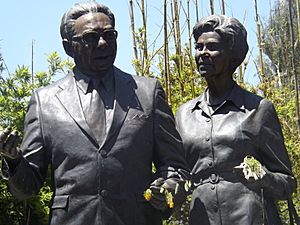Gladys Nicholls facts for kids
Quick facts for kids
Gladys Nicholls
|
|
|---|---|
| Born |
Gladys Naby Muriel Bux
21 October 1906 Cummeragunja Reserve, New South Wales, Australia
|
| Died | 28 January 1981 (aged 74) Melbourne, Victoria, Australia
|
| Other names | Gladys, Lady Nicholls |
| Spouse(s) |
Herbert Nicholls
(m. 1927–1942) |
Gladys Naby Muriel Nicholls, also known as Lady Nicholls, was an important Aboriginal activist. She was born Gladys Bux on October 21, 1906. She worked hard to help Aboriginal people in cities. Her efforts improved conditions and created support networks. She focused on Melbourne, Victoria, and other parts of Australia. Her work took place from the 1940s to the 1970s.
Contents
Early Life and Family
Gladys Bux was born at Cummeragunja Reserve. This reserve was in Yorta Yorta country. It was near Moama, New South Wales. Her mother, Alice Campbell, was a Djadjawurrung and Baraparapa woman. Her father, Meera Bux, was a Punjabi Indian merchant. He owned a general store in Barmah, Victoria.
Gladys went to school on the reserve. She also helped out in her father's store. Later, she worked as a dairy maid.
Moving to Melbourne
When she was 19, Gladys married Herbert "Dowie" Nicholls. His family was also from Cummeragunja. In 1939, many people left the reserve. They did this because of its strict rules and poor living conditions. Gladys and Dowie moved to Barmah after this "walk-off."
Later, they moved to Melbourne. There, Gladys worked in a factory that made supplies for the war. In 1942, Dowie sadly passed away. He was hit by a car and suffered head injuries. Gladys was left a widow with three children. Dowie's brother, Douglas Nicholls, helped the family. Douglas was a famous Australian rules footballer and a pastor. He married Gladys in December 1942.
Helping the Community
After World War II ended, Gladys Nicholls started working to help her community. Many Aboriginal people in Melbourne faced poverty. They also had other social problems. Gladys volunteered her time to address these issues.
Creating Support Systems
She taught in Sunday school. She also started a series of "opportunity shops" in Fitzroy. These shops sold donated items. Gladys knew that the community needed to raise money. This was because there was little help from the government. The money from these shops supported her community work.
In 1956, Gladys Nicholls opened a hostel for Aboriginal girls. It was in Northcote. She managed this hostel herself. It was first named "Cummeragunja" after her birthplace. Later, it was renamed the Lady Gladys Nicholls Hostel. This honored her important contributions.
Legacy and Recognition
Gladys Nicholls made a lasting impact. Her dedication helped many Aboriginal people. She created vital support networks. Her work improved living conditions in urban areas.
In 2008, Gladys Nicholls received special recognition. She was added to the Victorian Honour Roll of Women. This honor celebrates women who have made a big difference in Victoria.


